Apollo Six Led Grow Light 270 Watt 81 Ratio Red to Blue
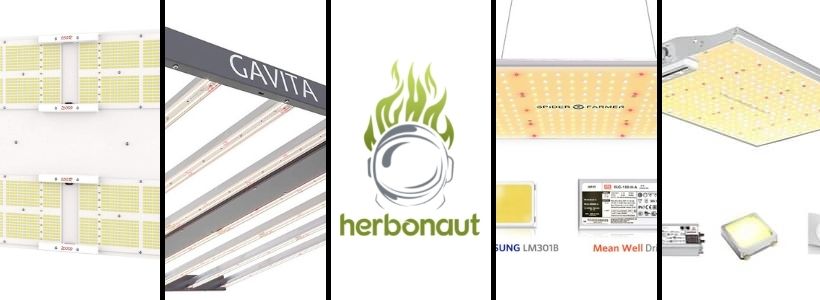
Today you're getting a review of the best LED grow lights that you can currently buy.
You're also going to become an LED grow light expert in less than 5 minutes.
You're going to get a simplified buyer's guide that covers:
- 2 easy-to-use rules you can use to decide how strong of a grow light to get for your setup;
- A step-by-step process to rate any LED light, and;
- Tips to optimize the performance of your light and maximize your yield.
Let's get started with our most recommended LED grow light.
1. Horticulture Lighting Group HLG 650R (Best Overall)
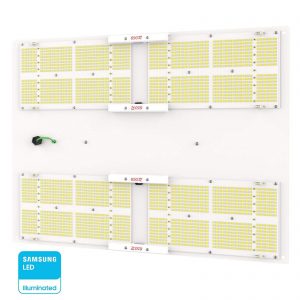 This light is the latest powerhouse grow light in Horticulture Lighting Group's catalog.
This light is the latest powerhouse grow light in Horticulture Lighting Group's catalog.
The most important upgrades compared to the previous flagship models of HLG are:
- Supplemental light that covers the deep-red and far-red wavelengths;
- Slightly stronger light intensity (went from 1700 to 1770 μmol/s), and;
- More efficient when we look at the μmol/j (went from 2.6 to 2.81 μmol/j).
This light comes with four full-spectrum white light quantum boards powered by:
- Samsung LM301H full-spectrum white diodes, and;
- LM351H V2 Deep Red 660nm diodes.
When it comes to:
- efficiency (μmol/j or light/watt), and,
- total light 'output'/intensity (μmol/s or light/second),
these LED diodes are currently the best you can get.
More generally:
White light has much better efficiency and total light output than any 'blurple' light.
Blurple LED grow lights are predominantly blue and red spectrum lights. 90% of budget LED grow lights are 'blurple' lights.
White light covers the full spectrum of wavelengths, including yellow and green (1).
The range of wavelengths that are important for plant photosynthesis has a name:
- Photosynthetically active radiation', or PAR.
PAR consists of all wavelengths that fall within the range of 400 to 700 nanometers.
Your plants will yield most when they're exposed to ALL wavelengths that fall within PAR. This includes green and yellow wavelengths.
The full contribution of these wavelengths in plant photosynthesis needs further research. But research shows that green and yellow wavelengths do have a role.
For example:
Green light stimulates photosynthesis deep within the leaf and canopy. Studies show green light contributes to carbon gain and crop yield (2).
White light more closely resembles the sun than blurple light. The closer your light imitates the sun, the higher quality your yield will be.
But recent insights show that plants also benefit from wavelengths that fall outside PAR:
- wavelengths that cover the deep- and far-red spectrum.
The deep- and far-red spectra of light are thought to be needed for the 'Emerson effect'.
The Emerson effect refers to the notion that two photosystems:
- one that is sensitive to the deep-red spectrum (680 nm) and,
- one that is sensitive to the far-red spectrum (680+ nm),
work together to optimize electron transport and photosynthetic rates. The Emerson effect is especially relevant in the flowering stage of plant's lifecycle (3).
Well, this light has the strongest and most efficient deep red LED diodes:
- the Samsung LM351H V2 diodes.
Any LED grow light that makes use of:
- Samsung LM301H diodes for full PAR coverage, and
- has supplemental Samsung LM351H V2 diodes for deep- and far-red spectra coverage,
is going to be great for your yield and your electricity bill.
The initial investment in a light with LM301H diodes may seem steep. But it will pay itself off big-time after a few successful grows. Why? Because you will keep the cost of the electricity bill down.
LM301H chips are currently one of the best chips for PAR-coverage and total light output. They're also one of the most efficient LED diodes that you can get. Compared to diodes like Epistar and Cree, they will keep the cost of electricity down.
The only technology that comes somewhat close in terms of:
- PAR coverage,
- total light output, and,
- efficiency,
is COB LED (chip-on-board LED).
And although COB technology will result in quality yield as well…
You can get the same result with less electricity when using Samsung LM301H diodes. Less electricity means a lower electricity bill.
Now:
When it comes to LED grow lights with Samsung LM301H diodes you have a few options. But if want your LED grow light to make use of Samsung LM301H diodes AND want:
- a light that comes from a reputable company that has its lights tested for years by thousands of growers;
- great build quality;
- supplemental light that covers the deep-red and far-red wavelengths;
- run a cool light;
- last longer than 1 year, and;
- 3-year warranty…
the HLG 650R is your best option for any 5×5 grow tent.
Especially the:
- cooling mechanism, and,
- proper spread of diodes,
are two extremely important factors that can make or break an LED grow light.
The passive cooling mechanism of all HLG quantum boards is with heatsinks. This is a very effective method . With most of their models, you probably won't need any active cooling (although it always helps).
Combine this effective cooling with:
- the most power-efficient white-light diodes, and,
- the right spread of diodes for improved canopy penetration,
and you have the perfect combination of features for an amazing yield…
While at the same time, keeping the electricity bill down.
- Click to see the most recent price – (Amazon / Grower's House)
Next up…
2. Gavita Pro 1700E (Most Reliable and Longest-Lasting)
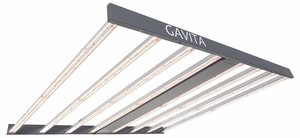 LED grow lights are evolving at a fast pace.
LED grow lights are evolving at a fast pace.
What was best 2 years ago, is now replaced with a new LED technology.
New technology in LEDs usually means stronger light for less electricity.
The Gavita Pro 1700E is a bit older than some other lights on the list. But it's still powered by the strongest and most efficient LED diodes:
- Samsung LM301B diodes.
While the LM301H diodes are newer, they're practically the same as the LM301B diodes. In terms of light output/intensity and efficiency, these diodes are extremely similar:
- 0.56 μmol/s, 3.10 μmol/J @ 65 mA (LM301H) vs. 38.8 lm, 220 lm/W @ 65 mA (LM301B).
While expressed differently, when you convert the numbers they're almost the same.
Don't get fooled by marketing tricks.
Just because LM301H diodes are newer, it doesn't mean they're better than LM301B diodes. They're not.
Although the Gavita Pro 1700E is one of the more expensive LED grow lights…
When you look at the power and quality of this light, you'll quickly understand why it has such a high price tag.
The Gavita Pro 1700E's output is rated at 1700 μmol/s. This is extremely high for an LED grow light. While it isn't the newest light on the list, it's still one of the strongest grow lights on our list.
Not only is it one the strongest lights on the list…
But when you look at its μmol/j we can clearly see it's also one of the most watt-efficient lights that you can get. It has an efficiency of 2.6 μmol/j.
But strong and efficient light isn't the only thing the Gavita Pro 1700E has going for it.
Although white light covers more PAR wavelengths than 'blurple' lights…
The deep-red and far-red spectrum aren't covered by both.
The Gavita Pro 1700E solves this with supplemental Osram deep-red LED diodes.
This light is closer to the sun than LED lights operating with just 'white light' diodes.
As you would expect from a premium LED grow light, you also get great build-quality with the Gavita Pro 1700E:
It comes with eight passively cooled LED bars that:
- provide very even light distribution across the whole canopy, and,
- keep the noise down.
You probably won't need any extra cooling with the Gavita Pro 1700E. Its built-in cooling mechanism is extremely effective.
The best part?
Gavita doesn't drive its diodes as hard as other lights on the list. Your diode-lifespan will be significantly higher compared to other lights. This means less color shifting and not needing a replacement for many years.
The bottom line:
The Gavita Pro 1700E is currently among the best LED grow lights that you can get. But you have to prepare to pay its premium price tag.
- Click to see the most recent price – (Grower's House / Amazon / LEDGrowLightsDepot)
Next up…
3. Spider Farmer SF (Best Budget Light)
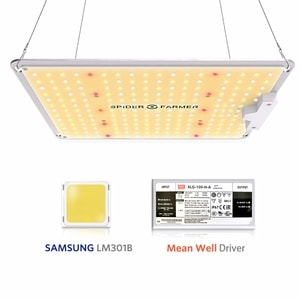 If you want to experience the power of Samsung LM301B diodes, but don't want to spend $800+ on a premium LED grow light from Gavita or HLG…
If you want to experience the power of Samsung LM301B diodes, but don't want to spend $800+ on a premium LED grow light from Gavita or HLG…
You'll be happy to know that there are cheaper alternatives.
Our most recommended budget-friendly alternative is the Spider Farmer SF LED grow light.
While the build quality of the Spider Farmer SF might not be as good as the Gavita or HLG lights…
The light intensity is only slightly worse…
But MUCH better than other budget LED grow lights.
The Spider Farmer SF has the same efficiency as all other lights with Samsung LM301B LED diodes. When we look at the advertised μmol/j, we can see that the Spider Farmer SF has an advertised efficiency of 2.7 μmol/j.
On paper, the Spider Farmer SF is even more efficient than the Gavita Pro 1700E.
What's even better:
Although the 'white light' emitted from the LM301B LED diodes covers a much wider spectrum of PAR than the average 'blurple' light…
White light doesn't cover the deep- and far-red spectra of PAR as much as you would like.
Spider Farmer lights are supplemented with deep-red LED diodes and infra-red chips.
The Spider Farmer SF lights cover an almost as wide spectrum of PAR as the Gavita Pro 1700E and the HLG 550 V2 R Spec.
- Click to see the most recent price – (EpicLEDGrowLight > 3% off coupon code: HERBONAUT/ Amazon)
Next up…
4. Scynce LED Raging Kush 2.0 (Most Advanced and Best for Vertical Growing)
 The biggest problem with getting a single grow light to cover your whole canopy, especially during the flowering stage, is:
The biggest problem with getting a single grow light to cover your whole canopy, especially during the flowering stage, is:
- even canopy penetration.
When you have a few plants, the buds at the:
- bottoms, and,
- sides,
don't receive light of the same intensity as the ones at the top.
With a single light, it's difficult to cover all angles of your grow area evenly…
But a few lights come with customized optics that spread light evenly over your canopy. Including the lowest parts.
And the Synce LED Raging Kush is the best option when it comes to even canopy penetration.
When you check the PPFD-chart, you'll see that in a 4×4 growing surface area, the average PPFD reading is 1057. This is from a height of 9 inches.
But the best part:
The minimum PPFD reading at the outskirts of the surface area is around 1000 (at 9 inches).
With some other grow lights on the list, the PPFD drops more than 50% at the outskirts of your growing area. This light stays consistent in literally every part of the surface area. It gives you at least 1000 μmol m(-2)s(-1) in even the furthest outskirts.
But also vertically, these lights deliver extremely consistent light intensity.
If hung between 6 and 18 inches, the patented Conic 120 optic helps deliver the same light intensity over the full canopy.
With an efficiency of 2.51 μmol/j, it's not the most efficient light on the list. But it's still more efficient than other types of grow lights like HPS lights.
Like all the other lights on the list, this is a true full-spectrum LED grow light. It comes with the following lights covering the following spectra:
- 475 watts of white light between 2700k and 6500k.
This covers 'cool' wavelengths like blue and green, and 'warm' wavelengths like yellow, red, and orange. And:
- 175 watts of deep and far-red light covering wavelengths between 660 and 730nm.
But what makes this light special compared to other full-spectrum lights on the list:
It has 'full power spectrum tuning'.
Let me explain.
You can control what specific wavelengths you want to cover with the allocated watts.
An example:
If you want to reduce blue wavelengths during the flowering stage, you dial up the red wavelengths. You won't reduce the total active watts. Even if you only want 'warm' white light during the flowering stage, you get the full 475 watts
By dialing up or down the different spectra, you can control the dominant light-type at any given time.
Want to support your plants during the vegetative stage and give them:
- thick stems, and,
- densely structured branches and leaves?
Turn up the 'cool' white light with blue wavelengths.
Want the most potent buds with the highest amounts of resin and trichomes? Turn up the 'warm' white light.
This is currently one of the most advanced LED grow lights that you can get.
But there are more highly noteworthy benefits that come with this light. The biggest one:
You get a 5-year full warranty on this light. This is above the industry average of 3 years.
You also get full wireless control over your light with the Android/iOS Theia app. With this app you can control:
- Intensity/dim from zero to max;
- Ramp on time (sunset/sunrise);
- Scheduling;
- The exact light spectrum of the light.
The bottom line:
If you're a vertical grower or want predominantly white light…
But want full control over exact wavelength coverage in different stages of the grow-cycle…
This is the light you should get.
- Click to see the most recent price – (LEDGrowLightsDepot)
Up next…
5. GrowCraft X6 ChilLEDTech (Best Thermal Management)
 While the exact LED diodes used in this light aren't disclosed…
While the exact LED diodes used in this light aren't disclosed…
When we look at the output and efficiency numbers, we can only conclude that they're made with the highest quality diodes.
The numbers:
- Efficiency: 2.81 μmol/j
- Output: 1647 μmol/s
As you can see the efficiency is as good as lights that are powered by Samsung LM301H diodes. The output is a bit lower.
While I can't say with certainty, there's a big chance Samsung LM301H diodes power these lights. The numbers don't lie.
The full spectrum of wavelengths within PAR are covered by this light. Its coverage of wavelengths is the same as other high-quality white lights.
The GrowCraft X6 has especially good coverage of the red and far-red spectra. This means that this light will perform exceptionally well in the flowering stage.
This light, as well, comes with Mean Well dimmable LED drivers. It has a dimmable watt-range of 30-600 watts.
The GrowCraft X6 comes with two different options:
- Flowering optimized spectrum, and;
- Vegetative cycle optimized spectrum.
If you have a lot of money to spend, you could get both of them.
But if you only want to get a single light, I recommend getting the flowering optimized version. Based on PPFD-chart published by ChilLED, this may be the highest-yielding LED grow-light on the list for a 5'x5′ canopy area. It has the highest PPFD values even towards the edges of the coverage area.
Now:
The Growcraft X6 is another option among high-quality lights that all have similar:
- light intensity,
- efficiency, and,
- coverage of wavelengths that are best for growing plants like cannabis.
But what makes the Growcraft X6 special compared to the other options is its temperature control. This light runs a bit cooler than the other premium lights on the list. The stated operating temperature of grow lights isn't always accurate. Yet this light truly doesn't get hotter than the stated maximum operating temperature of 95°F/35°C.
It comes with a 3-year limited warranty, which is about the industry average.
- Click to see the most recent price – (Chilled Grow Lights)
6. Mammoth Lighting Commercial Series (Best Value)
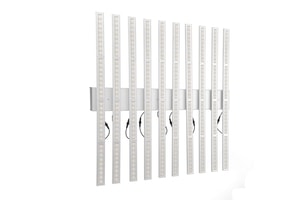
If you're looking to replicate the sun, the Mammoth Lighting Commercial Series will get you very close.
This is a full-spectrum light in the most real sense of the word:
90% of LED grow lights are so-called 'blurple' lights. They provide light in the blue and red spectra. The Amare Mammoth Lighting Commercial Series provides light in the FULL PAR-spectrum. This includes the green spectrum.
It has a very balanced ratio of wavelengths. It even includes the far-red spectrum which is needed for the Emerson effect.
It gets even better:
UV-light increases THC percentages in cannabis (4). Any light can easily be supplemented with UV-light, with a simple UV-bar.
This light is a real powerhouse and literally replicates the sun. Don't take my word for it. If you check the PPFD readings (found on the product page), you'll see this light's PPFD values are off the charts. Not only regarding pure output, but also the coverage area.
The coverage area of this light is bigger than other same-watt budget lights on the list. To compare coverage areas, we use the 'minimum of PPFD of 510 μmol m(-2)s(-1) for the full coverage area' rule.
When looking at the power draw of this light, you'll see this light has a very high PPFD output per watt (PPFD/WATTS).
Here's how they achieved this:
The main LED chips used in this light are the Samsung LM301B diodes. But it also includes chips that cover the red spectrum (660nm).
The Mammoth Lighting Commercial Series has the best build quality on the list. The cooling is really on point, you won't need any additional cooling with this light. plus you get a 3-year warranty in case anything goes wrong. 3-years of warranty is right around the average in the LED industry (the average is 2-3 years).
What's the bottom line?
If you find the HLG and Gavita lights too expensive, but are looking for a bit better quality than the budget lights on the list …
The Mammoth Lighting Commercial Series is the light you should get.
- Click to see the most recent price – (Amazon / LEDGrowLightsDepot)
Last on our list is the…
7. VIPARSPECTRA XS Series (Cheapest)
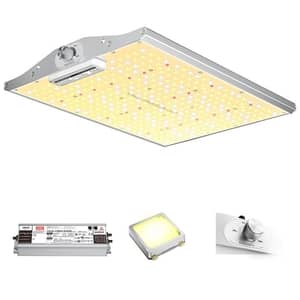 The VIPARSPECTRA XS Series is similar to the SpiderFarmer SF light. It's a Chinese budget light that provides excellent value for its price.
The VIPARSPECTRA XS Series is similar to the SpiderFarmer SF light. It's a Chinese budget light that provides excellent value for its price.
Keeping all other variables like watts per square foot the same…
The quantity and quality of your yield with these lights will be worse than with the SpiderFarmer SF.
This comes as no surprise as the light intensity (PPFD) of this light is the lowest on the list (still good though).
The build quality of this light is also slightly worse. But it's also quite a bit of a cheaper light than the other lights on the list!
This is the cheapest grow light on the list.
Go cheaper than this, and you'll probably waste money on a subpar light. The VIPARSPECTRA XS Series is the cheapest you should go with a LED grow light.
Now:
Even though the old VIPARSPECTRA LED lights were strongly skewed towards the blue spectrum and therefore most suited for the vegetative stage in your growing cycle…
The new XS series comes with Samsung LM301B diodes. It has a much more balanced coverage of the full spectrum of light and PAR specifically.
This series is perfectly suitable both for the vegetative and flowering stage.
Also because the price is so low, you can get a few VIPARSPECTRA XS Series lights, for the same cost as a high-end light. What option will give you better yield depends on many factors.
If you're looking for a budget light, you can't go wrong with ViparSpectra XS series.
Also, if you're looking for the cheapest of the cheapest , which will still get you good results…
This is the light you should go for.
- Click to see the most recent price – (Amazon)
LED Light Accessories
Most lights come with a hanging kit.
But if not, you will need a way to hang your lights.
And the best way to do that is with some quality:
- Rope Ratchets– (Amazon)
These rope ratchets are sturdy as hell.
But again, most lights come with a hanging kit!
If you want to make things easy on yourself, you should also get a timer to control your light cycles:
- Honeywell Timer – (Amazon)
Otherwise, you'll have to manually turn on/off your lights, which is a hassle, trust me.
What to Look for And How to Rate LED Grow Lights
Light is the main ingredient for growing high-yield plants.
But how can you rate the quality of light?
Well, it's precisely the:
- Range and ratio of different wavelengths/colors of light,
- Your light's intensity, and
- Your light's efficiency,
which are the most important when rating a LED light.
And the only true way to measure these metrics is not by watts per square foot or lumens as most people think, but by:
- PAR,
- PPFD,and to a lesser extent,
- PPFD/Watt ratio.
Let me explain what these abbreviations mean.
What's PAR and Why It's Important
PAR stands for 'Photosynthetically Active Radiation.'
PAR is the range of all the different wavelengths/colors of light that plants use for photosynthesis (5).
Some LED light manufacturers wrongly use the term PAR when talking about light output. But PAR is not a way to measure the intensity of your light.
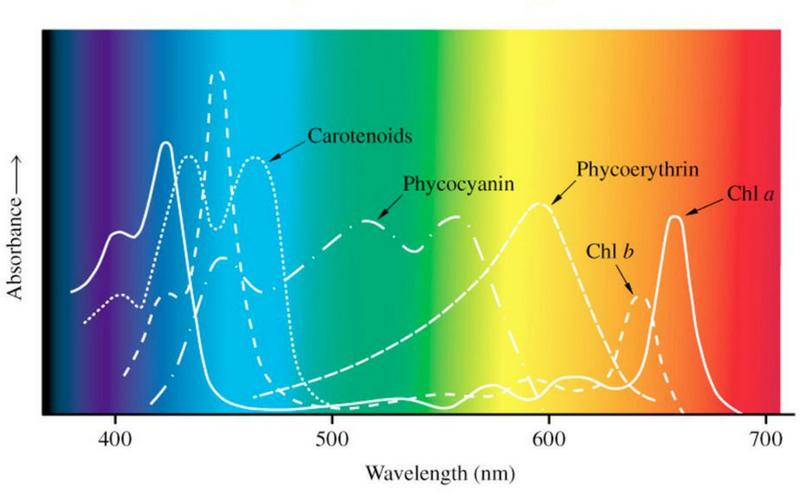
Now:
For your plants to grow optimally, your LED light should have all the different wavelengths/colors of light that makeup PAR. But especially important are:
- The blue wavelengths (for vegetative growth), and;
- The orange/red wavelengths (for the flowering process).
Most LED manufacturers are aware of PAR and design their lights in such a way that PAR is well covered.
The lights in this list have settings with optimized spectra for that particular stage in the grow cycle. You can quickly activate these specific settings with a simple switch.
This is also the main reason why LED lights are more efficient than HID lights (HPS and MH).
HID lights emit ALL the different wavelengths/colors all the time. This even includes wavelength/colors that fall outside of the PAR range!
What this means is that HID lights waste quite a lot of electricity. Why? Because they're using power for wavelengths that fall outside the PAR range. Most of these wavelengths are useless for your plants.
If you get the right LED light, your light will have the wavelengths that fall within the PAR range. But also wavelengths that fall within the deep and far-red spectrum (which are essential for the Emerson effect). Your light will largely emit light that's actually used by your plants. This way, little to no electricity goes to waste.
But as you now understand:
PAR doesn't say anything about the light's intensity. It's just a range of wavelengths. Light intensity is key in rating a grow light and getting strong plants with monster yields as well.
What's PPFD and Why It's Important
PPFD stands for 'Photosynthetic Photon Flux Density.'
PPFD is a measurement of light intensity. It says how many light photons that fall within the PAR-range hit a given square meter per second. It's expressed in micromoles, like μmol m(-2)s(-1).
A photon is the most basic and smallest unit of light.

Essentially, what PPFD does, is measure the intensity of your light.
This means to rate the quality of a LED light, PPFD is one of the most critical metrics .
Of course, there are also metrics like:
- build quality,
- how much heat the light generates and its thermal management,
- reputation and reliability, and,
- customer service,
that you should consider when choosing a LED grow light.
But PPFD is what mostly matters to your plants. And what matters most are the PPFD values in the orange/red wavelengths. Why? Because these are the wavelengths that have the most impact on your yield.
Below you can find how much PPFD you need at the minimum for a good cannabis grow:
- 255 μmol m(-2)s(-1) – 347 μmol m(-2)s(-1) PPFD on a 24 hours light schedule.
- 383 μmol m(-2)s(-1) – 520 μmol m(-2)s(-1) PPFD on a 18 hours light schedule.
- 510 μmol m(-2)s(-1) – 694 μmol m(-2)s(-1) PPFD on a 12 hours light schedule.
I can't emphasize this enough:
The guideline above is the minimum PPFD you'll need to produce a decent yield.
Your plants will yield more in the flowering stage if you they get light that equals a PPFD value between (6):
- 700 – 1500 μmol m(-2)s(-1)
This is the range where your plants will thrive in the flowering-stage. Except if you grow on a a 24-hour light schedule, but a 24-hour light schedule isn't the best practice anyway.
But keep in mind this is the average PPFD value.
For optimal results, you never want your PPFD to drop below 510 μmol m(-2)s(-1). You also never go above 1500 μmol m(-2)s(-1) at any given point of the coverage area.
The best PPFD value is a controversial subject, and is among other things, highly dependent on:
- Whether you're supplementing with CO2;
- The grow stage in which your plants are: in the flowering stage your plants will need more intense light;
- Your specific strain. Sativa-dominant strains thrive under more intense light than Indica-dominant strains, and;
- Your light cycle: the longer your period of light, the lower the optimal PPFD value is and vice versa.
Note: Realize that LED manufacturers grossly overstate the coverage areas of their lights. Usually at the outskirts of the advertised coverage area the, PPFD drops way below 510 μmol m(-2)s(-1). This will negatively affect your yield (you'll get airy instead of dense buds). Something to keep in mind if you don't want to go for anything less than a fantastic yield
Can light be too intense?
The threshold of 'too intense' light is above 1500 μmol m(-2)s(-1). The exact value is also dependent on several factors like:
- CO2 levels,
- your strain, and,
- temperature.
But as long as you respect the minimum height distance as advertised by the manufacturer…
You won't get very quickly close to the threshold with the lights on this list.
Note: The most important thing is always to keep an eye on your plants. Look out for signs of stress and light burn, and if you see any, start raising your lights by a few inches. Don't blindly follow the advice in this article or any other article for that matter. Always test yourself!
There's a HUGE 'but' with PPFD though…
Even if we know the PPFD of a particular LED light, we usually don't see how it was measured.
If you measure PPFD in the center below the light, you will get different values than to the sides and corners. The further you get from the center of your LED light, the quicker the PPFD values drop.
You will also get different PPFD values if you measure from different heights. The closer you measure to the light, the higher your PPFD will be.
So when reading PPFD values, it needs to be 100% clear what:
- The distance was between the LED light and the canopy (or simply the floor);
- What the PPFD values were in the different parts of the coverage area, not only the center. Also what the values were from different heights ;
- The PPFD values are for the different wavelengths within the PAR-range. This one is tricky and is almost never provided, but in an ideal world we would have this info as well.
If you have the PPFD values, including all this information, you have a reliable way to compare lights. And you'll know for sure how one light compares to another on light intensity.
But the sad truth is:
Most LED light manufacturers don't provide all these PPFD-reading-related background information.
Either they provide no PPFD values at all or a general PPFD value, with no background information.
A single PPFD value without any background information is useless information. It doesn't tell us exactly about the light's spread, its penetration or even its intensity.
Note: Some LED manufacturers do provide PAR value charts (PPFD charts) of the light's coverage area. It's always worth it to ask for such a chart. Here's how such a chart looks like:
If you want an amazing yield, the PPFD should never drop below 510 μmol m(-2)s(-1) in the flowering stage. And as you can see with the light above, PPFD drops fast towards the edges.
Although the light gets advertised with a 4×4 ft. coverage area, should you grow according to the '510 μmol m(-2)s(-1) rule', it would only cover between 2×2 ft and 3×3 ft.
So always take the coverage area of the manufacturer with a grain of salt.
If PPFD isn't 100% reliable either…what's left?
We don't wholly toss away PPFD in the garbage can.
It's not the most reliable metric because of the often-lacking background information. But depending on the transparency of the LED light manufacturer, it does say something.
To get the full picture in a world without reliable PPFD measurements…
We're also going to have to look at the results of different lights in different growing setups. This means reading and comparing lots of grow journals.
And EVEN this rating process has many caveats.
You can't just compare one setup to another. There are countless variables that impact the yield of a grow beside lighting.
That said, when we compare similar grow setups, where only the LED light used, is different…
We can very cautiously conclude which LED lights provide a higher yield than others.
So when rating the quality of the light that comes out of a LED grow light, these are the things we look at:
- PAR: which wavelengths have the highest output by the light. You want blue and red wavelengths mostly, but not only ! You want the full PAR spectrum , including the green wavelengths. Plus the far-red spectrum (which falls outside of PAR).
- PPFD: are there any values provided for different wavelengths in the PAR-range. And do we know how it's measured and calculated.
- Grow journals: compare the yield of in the same setups, where only the light differs (has many caveats as well!).
The bottom line when rating LED lights is:
100% objectively rating LED lights is quite tricky.
It would be easier if manufacturers had PPFD measurements with all the background information.
But using:
- PAR coverage,
- PPFD, and,
- grow journals,
we can get an excellent idea of the quality of light coming out of a particular LED light.
Now you know how to rate the quality of light coming out of a LED light…
It's time you understand how many watts to get for your specific space/setup.
Watts per square foot as a metric doesn't say much about the light's intensity. But it's a decent way to decide how big and powerful of a light you need to get for the size of your specific grow setup.
Unless of course, you've got reliable PPFD / PAR value charts, but you probably won't!
How to Choose a LED Light for Your Specific Setup Using Watts
As a general guideline, you should try to get a minimum of 50 watts per square foot with a LED grow light. This guideline is by no means perfect but will help to get you started.
50 watts per square foot means that:
- A 400W LED grow light will cover a 2.5 X 2.5 ft space.
- A 900W LED grow light will cover a 4 X 4ft space.
- A 1600W LED grow light will cover a 5 X 5ft space.
But here's the kicker:
I'm talking about the real wattage value ! I'm talking about the actual power draw, the actual watts that your light pulls out of the wall.
Let me explain.
Many LED light manufacturers give their specific model a name like 'MARS II 400W'. The confusing part here is the '400W'. A MARS II 400W does not have a real wattage value of 400. Its actual power draw is 162 watts.
So ALWAYS look for the true wattage value/actual power draw of a light.
Don't get confused by the name of the light.
Below you can see an example of what I mean:
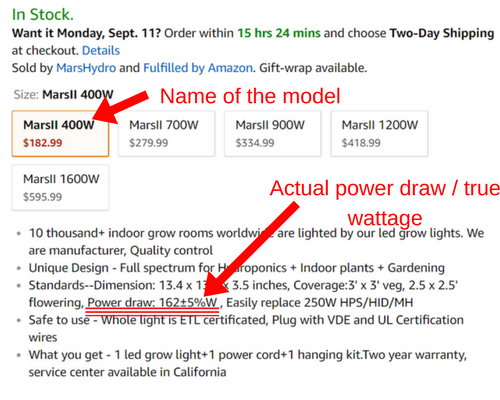
Note: If there are different wattage values for different grow cycles, take the value of the blooming setting. The 50 watts per square foot is most important in the flowering stage. In the vegetative stage, you can do with less.
Example: This means that with a 3×3 ft. space (9 sq. ft.), you will need at least 9×50 = 450 watts of actual power draw.
Why does all this matter?
Most lights get advertised with a coverage area that's grossly overstated. Not only when keeping the 510 μmol m(-2)s(-1) rule in mind, but also when keeping the minimum of 50 watts per square foot in mind.
Note: A premium LED grow light that makes use of power-efficient diodes like the Samsung LM301B diodes, can do with fewer watts per square foot. Around 30 watts/sq. foot.
What's the bottom line when choosing a specific LED model?
There are 2 ways you can choose a specific model.
Best method:
You have PPFD / PAR-value charts, and you make sure that no part of your growing area goes below a PPFD of 510 μmol m(-2)s(-1);
Realistic method:
You don't have PPFD / PAR-value charts, and you go for a minimum of 50 watts per square foot.
The first method will result in a better quality yield but will be more expensive. You'll need more 'light' to achieve this. And you'll need reliable PAR-value charts which are often not provided.
The second method will result in a decent yield and will be cheaper and easier most of the time. Why? Because most LED manufacturers don't provide PPFD / PAR-value charts.
Also, do realize the following when choosing a specific model:
Often, it's better to get a few lower wattage LED lights instead of getting a single high wattage LED light. You can position them in such a way that all angles are covered.
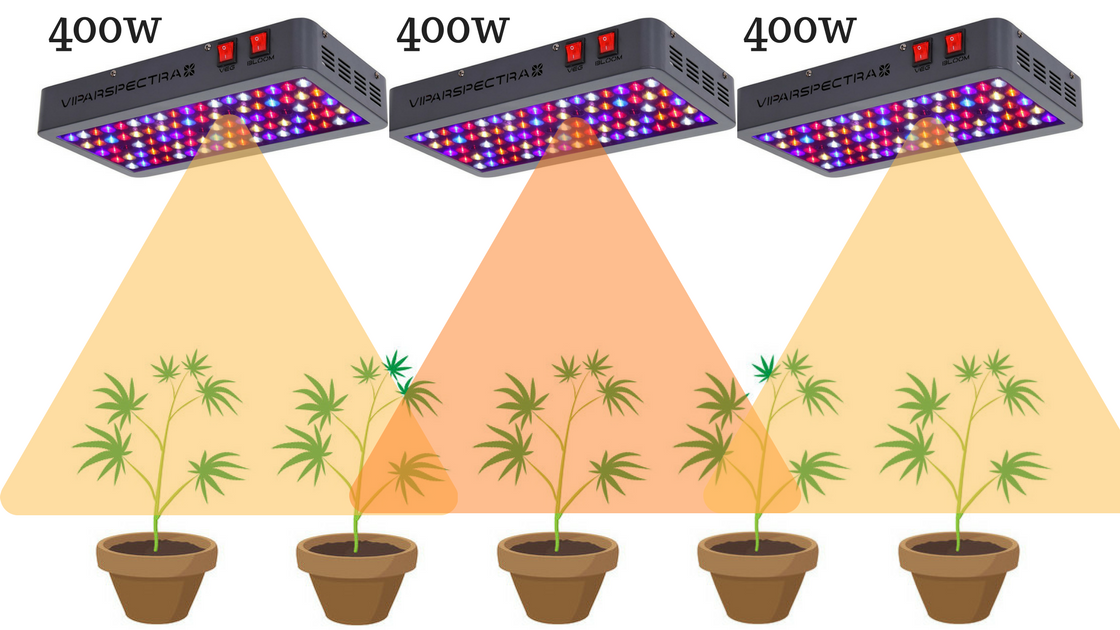
This is because LED doesn't have the best spread compared to other types of lights. The more lights you have, the better you can position them and the better the spread of your light will be.
What's the right distance to keep your LED lights from your plants
It's crucial that you put your lights as close as possible to your plants, without causing light burn.
Why?
Because this will directly affect the potency of your buds.
But it's just as important not to put your lights too close to your plants.
But what's 'too close'?
This is highly dependent on the light's brand and model.
The more powerful the light, the higher the distance between your light and your canopy should be.
LED manufacturers always provide minimum distances with their products. You should use these.
Keep a close eye on your plants and act accordingly:
- Raise them in a few inch increments when they show signs of stress/light burn, and;
- Lower them when you feel your plants need more intensity.
One Last Word
You don't have to go for a premade LED light.
If you're tech-savvy, you could build your own LED kit.
There are many guides and tutorials on the web, which will show you how to build a potent LED light that:
- will be quite a bit cheaper than the premium premade LED lights,
- but will provide close to the same quality of light.
Just prepare and take your time to do all your homework in case you go this route.
What's Next…
If you want to make sure you have all the supplies to grow your marijuana, check the following guide:
- 10 Essential Marijuana Growing Supplies
If you have all your supplies and want a step-by-step guide on how to successfully finish your first grow, check out this guide:
- How to Grow Marijuana
If you need a quality grow tent, check out our buyer's guide on:
- The Best Grow Tents
If you're looking for a fantastic strain for your first indoor grow, check out our:
- Definitive Guide to Marijuana Seeds
Lastly, if you want to connect with us, become a fan on Facebook or follow us on Instagram by clicking the links below.
Scientific References:
- Hamdani, S., Khan, N., Perveen, S., Qu, M., Jiang, J., Govindjee, & Zhu, X. G. (2018). Changes in the photosynthesis properties and photoprotection capacity in rice (Oryza sativa) grown under red, blue, or white light. Photosynthesis Research, 139(1–3), 107–121. https://doi.org/10.1007/s11120-018-0589-6
- Smith, H. L., McAusland, L., & Murchie, E. H. (2017). Don't ignore the green light: exploring diverse roles in plant processes. Journal of Experimental Botany, 68(9), 2099–2110. https://doi.org/10.1093/jxb/erx098
- Li, D., Li, W., Zhang, H., Zhang, X., Zhuang, J., Liu, Y., . . . Lei, B. (2020). Far-Red Carbon Dots as Efficient Light-Harvesting Agents for Enhanced Photosynthesis. ACS Applied Materials & Interfaces, 12(18), 21009–21019. https://doi.org/10.1021/acsami.9b21576
- Lydon, J., Teramura, A. H., & Coffman, C. B. (1987). UV-B RADIATION EFFECTS ON PHOTOSYNTHESIS, GROWTH and CANNABINOID PRODUCTION OF TWO Cannabis sativa CHEMOTYPES. Photochemistry and Photobiology, 46(2), 201–206. https://doi.org/10.1111/j.1751-1097.1987.tb04757.x
- Niu, Z., Wang, L., Niu, Y., Hu, B., Zhang, M., & Qin, W. (2018). Spatiotemporal variations of photosynthetically active radiation and the influencing factors in China from 1961 to 2016. Theoretical and Applied Climatology, 137(3–4), 2049–2067. https://doi.org/10.1007/s00704-018-2727-7
- Chandra, S., Lata, H., Khan, I. A., & Elsohly, M. A. (2008). Photosynthetic response of Cannabis sativa L. to variations in photosynthetic photon flux densities, temperature and CO2 conditions. Physiology and Molecular Biology of Plants, 14(4), 299–306. https://doi.org/10.1007/s12298-008-0027-x
springerreareento.blogspot.com
Source: https://www.herbonaut.com/best-led-grow-lights/
Post a Comment for "Apollo Six Led Grow Light 270 Watt 81 Ratio Red to Blue"